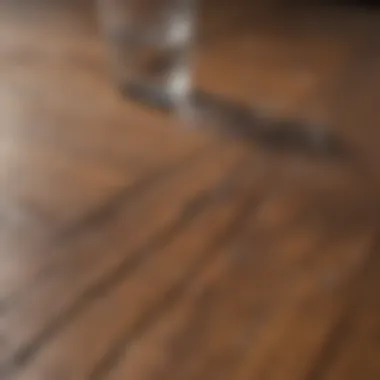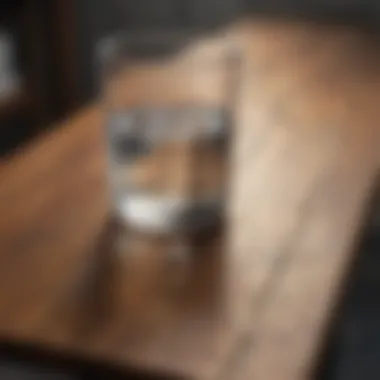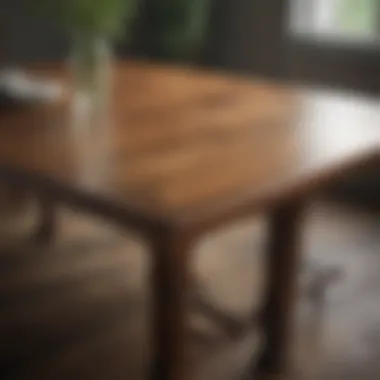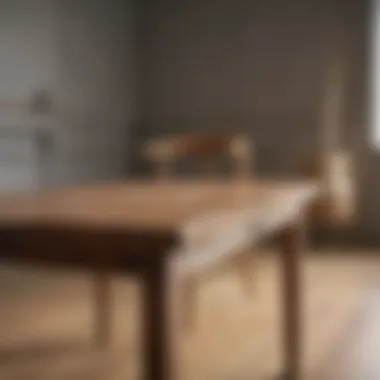How to Remove Water Marks from Wooden Tables


Intro
Water marks on wooden tables can be an eyesore. They arise from hot cups, condensation, or spills, and they often seem impossible to remove. Understanding how to effectively eliminate these stains is crucial for the longevity and aesthetic appeal of your wooden furniture.
This guide presents methodologies for different treatments depending on the finish of your wood. Expertise in restoration techniques not only restores the beauty of your tables but also protects them from future damage.
By learning the root causes of these stains and applying preventative measures, you can maintain the elegance of your wooden surfaces longer. With practical solutions outlined in this article, you can be equipped to handle any unexpected blemishes.
Understanding Water Marks on Wooden Tables
Types of Water Marks
Water marks come in various forms, each indicating a different type of damage. Recognizing these types is a first step in addressing the issue appropriately.
White Rings
White rings are a common form of water mark found on wooden tables. These marks are typically caused by condensation or moisture from cold drinks. The key characteristic of white rings is their light appearance, indicating that the finish has not been penetrated deeply. For many, dealing with white rings is beneficial as they are often easier to remove than other types of water marks.
The unique feature of white rings is their visibility in contrast to the dark wood. This can cause distress for homeowners who prioritize aesthetics. However, the relatively superficial nature of these marks often allows for successful removal with simple techniques, making it a manageable issue for most.
Dark Stains
Dark stains present a more severe challenge when it comes to water marks on wooden tables. Unlike white rings, dark stains indicate that moisture has penetrated through the finish and affected the wood itself. The key characteristic here is the deep discoloration that can be very noticeable on lighter finishes.
While dark stains are a common concern, they are often a less favorable choice for individuals who want to restore their furniture because they may require more extensive treatment. However, understanding that dark stains can signify underlying issues with the finish can guide homeowners toward appropriate methods for remediation, fostering a deeper respect for the maintenance of their wooden tables.
Surface Etching
Surface etching is another type of water mark that can impact wooden tables. Etching can occur when harsh chemicals or cleaning agents react with the finish of the wood, leaving a dulled or rough patch. The key characteristic of surface etching is the texture it creates, which may be more pronounced than color differences.
Surface etching is a significant concern for those who care about the longevity and quality of their wooden furniture. Although it may seem like a superficial problem, etching can lead to more substantial damage if not addressed. The unique aspect of this type of damage is that treatment may require more than just polishing; it can necessitate refinishing or even replacing the finish entirely to restore the surface's original texture.
Cause of Water Marks
Understanding the causes of water marks on wooden tables informs how we can prevent them. Multiple factors contribute to the formation of these marks, often stemming from everyday activities.
Condensation from Drinks
Condensation from drinks is a primary cause of white rings on wooden tables. When a cold beverage is placed on a warm surface, moisture collects at the bottom of the glass and can infiltrate the wood finish.
The key characteristic of this cause is its commonality in social settings. Many people use wooden tables for dining or entertaining, making it a frequent concern for homeowners. Recognizing this should prompt owners to consider protective measures. Preventative techniques can include using coasters to minimize moisture contact, which can significantly reduce the occurrence of such marks.
Spilling Liquids During Use
Spilling liquids during use is another common cause of water marks. This mishap can lead to both surface stains and deeper marks, depending on the nature and quantity of the liquid spilled.
The key characteristic of this cause is its unpredictability. Unlike condensation, spills often happen unexpectedly, which can make them more challenging to manage. However, understanding this can encourage people to be more vigilant while using their tables, potentially avoiding damaging accidents.
Improper Cleaning Techniques
Improper cleaning techniques are significant contributors to water marks on wooden tables. Using abrasive materials or harsh chemicals can damage the wood's finish, creating an opportunity for moisture to penetrate.
The key characteristic of this cause is its preventability. Homeowners can easily adapt their cleaning routines to use gentler methods and products specifically designed for wood care, thus minimizing the risk of water marks over time. Awareness and education about suitable cleaning techniques are vital for preserving the quality of wooden furniture, which benefits both longevity and appearance.


Preparation for Water Mark Removal
Preparing to remove water marks from wooden tables is an essential step that can significantly impact the effectiveness of the restoration process. Proper preparation can help ensure that the removal techniques you choose will work optimally while also protecting the wood from further damage. This phase involves assessing the damage, examining the wood type, evaluating the finish, and gathering appropriate supplies. Each of these components plays a crucial role in how well the methods will perform. Furthermore, taking the time to prepare helps avoid potential mishaps that can arise from rushing into the cleaning process without the necessary knowledge or tools.
Assessing the Damage
Identifying the Wood Type
The first step in assessing the damage is identifying the wood type. This is important because different types of wood react differently to moisture and cleaning solutions. Common wood types include oak, maple, cherry, and pine, each having unique characteristics in terms of grain, durability, and susceptibility to stains. For instance, oak tends to be more resilient than pine, which is softer and can be more easily damaged.
Knowing the wood type allows you to choose the appropriate cleaning method. Some woods can take more aggressive cleaning solutions, while others may require gentler approaches. This understanding is beneficial, as it can prevent further damage. An important aspect to consider is the wood's finish; certain finishes are more forgiving of moisture exposure, while others require more careful handling. Identifying these factors ensures that you can choose an effective removal technique without compromising the wood's integrity.
Examining the Finish
After identifying the wood type, the next step is examining the finish. The finish can be lacquer, varnish, oil, or polyurethane. Each type of finish provides a different level of protection from moisture and stains. Understanding the finish is crucial, as it dictates the kind of products and methods suitable for restoration. For example, oil finishes may require gentle cleaning, while varnished surfaces can handle stronger solutions.
An important characteristic of the finish is how it interacts with water marks. Some finishes might hide the stains better than others, making them seem less severe. Additionally, knowing the finish type helps in selecting a compatible polish or cleaner. If you mistakenly use a product that is too harsh for the finish, you may strip it away, resulting in more extensive damage. Thus, a careful examination of the finish is vital for a successful restoration process.
Gathering Necessary Supplies
Soft Cloths
Soft cloths are essential when preparing to remove water marks. They provide a gentle touch that helps avoid scratching the wood surface. The key characteristic of these cloths is their absorbency, which allows for effective cleaning and drying without causing unnecessary harm. Using soft cloths also ensures that any cleaning solutions applied do not spread the stains further.
In this article, soft cloths are a popular choice because they are widely available and easy to handle. They come in various materials, such as cotton or microfiber, which are both effective at lifting moisture and dirt. However, it is essential to avoid using rough or abrasive materials, as these can damage the finished surface and exacerbate existing marks.
Wood Polish
Wood polish is another critical supply in the preparation phase. It not only helps in the removal process but also aids in restoring the wood's protective layer and shine. The key characteristic of wood polish is its ability to nourish the wood while providing a barrier against future stains. Choosing a polish suitable for your specific wood type and finish is crucial for the most effective results.
Wood polish can be beneficial, as it can help blend out minor imperfections left behind after the water mark removal. Nevertheless, overusing polish can lead to build-up, making it less effective. It is important to follow the application instructions carefully to avoid this pitfall.
Baking Soda or Toothpaste
Baking soda and non-gel toothpaste are household items that serve well in this context. Their mild abrasiveness makes them effective for lifting stains without damaging the wood. This characteristic allows for tackling stubborn marks while providing a gentle cleaning option. Both baking soda and toothpaste are readily available and inexpensive, offering practical benefits for the homeowner.
However, the unique feature of baking soda lies in its versatility—it can be used in various cleaning situations beyond furniture. Toothpaste is often a popular choice due to its ready availability in most households, however, one must ensure it does not contain any additives that can leave additional residues on the wood surface.
Iron or Blow Dryer
Using heat from an iron or blow dryer is an effective method when preparing to remove water marks. The heat helps drive moisture out of the wood, allowing for a more thorough removal process. The key characteristic of using these tools is their ability to provide controlled heat that can help lift water marks more effectively.
Ironing is typically preferred for larger surfaces, but a blow dryer can be convenient for small areas. It's important to use these tools carefully; excessive heat can damage the finish instead of helping remove the stain. Additionally, using a cloth barrier between the heat source and the wood surface enhances safety and effectiveness. Ultimately, the use of an iron or blow dryer can be a powerful ally in the fight against water marks, when executed correctly.
Remember: Preparing properly by assessing the wood type, examining the finish, and gathering the right supplies will set the stage for an effective water mark removal process.
Methods for Removing Water Marks
Removing water marks from wooden tables is a process that holds significant importance for preserving the aesthetic and functional qualities of your furniture. Water marks can detract from the natural beauty of the wood and impact its longevity. Employing proper techniques not only addresses the immediate concern but also enhances the overall care of the furniture. This section discusses various methodologies, highlighting their distinct characteristics, benefits, and considerations for effective stain removal.
Using Heat
Using a Cloth and Iron
The method of using a cloth and iron is a traditional approach with proven effectiveness. Heat is applied carefully to a dampened cloth placed over the water mark. The warmth penetrates the wood, encouraging moisture to evaporate and thus lifting the stain. This technique is beneficial because it requires minimal supplies, making it accessible and easy to execute.


One key characteristic of using a cloth and an iron is its simplicity. It can restore the wood without the need for complicated materials or chemicals. However, care must be taken to set the iron at a low temperature to avoid scorching the wood. The primary advantage of this method is the low risk of damage when performed correctly. A notable disadvantage could be its ineffectiveness on very stubborn stains, which may require further measures.
Employing a Hair Dryer
Another method to consider is employing a hair dryer. Similar to the cloth and iron, this method utilizes heat to eliminate moisture embedded in the wood. This technique is beneficial for its convenience; it can be quickly implemented and adjusted based on the intensity of the water mark.
The key characteristic of using a hair dryer is the ability to control the heat application more precisely. This can be useful for larger or more distributed water marks. Additionally, the hair dryer can be used at a safe distance to prevent overheating. A point to consider, however, is that excessive heat can damage the finish of the wood, thus requiring a careful approach. Overall, when managed with caution, a hair dryer can offer a swift solution for minor stains.
Using Household Items
Baking Soda Paste
Baking soda paste is often praised for its gentle abrasive qualities. When mixed with water to form a paste, it can effectively lift water marks without damaging the surface of the wood. This method stands out due to its availability in most homes and its eco-friendly nature, which appeals to a wide audience.
The main characteristic of this technique is its non-toxic formulation, making it safe for regular use. Applying a small amount of baking soda paste to the affected area, followed by a gentle rub, will typically yield positive results. However, this method might not work as effectively on deep or long-standing stains. It is best suited for fresh marks or those that haven’t penetrated deeply.
Toothpaste Application
Toothpaste application is another unconventional yet effective method. Non-gel toothpaste can be applied to the stain, leveraging its mild abrasiveness to lift water marks. This approach can be appreciated due to the fact that many people already have toothpaste at home.
A notable benefit of using this method is its ability to tackle stains without harsh chemicals. The unique feature here is the subtle abrasiveness of toothpaste, which can gently scour the surface. An advantage is that it often works well on minor stains without risking significant damage. The drawback, however, is that like with baking soda, it may not be sufficient against tougher marks or stains that have been there for a longer duration.
Using Commercial Products
Furniture Polish
Furniture polish is a readily available commercial product that can be effective at removing water marks. Designed specifically for wood care, these products can restore shine while erasing imperfections. The key characteristic of furniture polish is its formulation, which often includes oils that nourish the wood and protect the finish.
Using furniture polish can be beneficial as it not only addresses water marks but also aids in overall wood maintenance. It can leave the surface feeling smooth and looking revitalized. However, one must be cautious about using products with strong solvents that might react negatively with the wood finish itself, causing further damage.
Specialized Wood Cleaners
Specialized wood cleaners are crafted to address various wood conditions, including water marks. These products provide a professional-level cleaning and conditioning option. The use of specialized cleaners is beneficial for those looking for a solution tailored to the unique needs of their furniture.
The unique feature of specialized wood cleaners is their comprehensive formulations, which can include conditions and reparative agents specifically designed for different types of finishes. The advantage of using these products is that they often deliver more consistent and reliable results. On the flip side, they may come at a higher cost compared to standard cleaning products, which could be a consideration for some homeowners.
Advanced Techniques for Stubborn Stains
Water marks can sometimes be persistent. This section discusses advanced techniques that may be necessary when the basic methods fail. Understanding and applying these techniques can be vital for restoring the original look of your wooden table. Each method has unique characteristics and associated benefits. While these techniques may take more time and effort, they can yield significantly better results.
Sanding and Refinishing
Choosing the Right Grit Sandpaper
Choosing the proper grit sandpaper is critical when sanding wooden surfaces. This choice directly influences how effective the sanding will be. The grit number indicates the size of the sand particles. A lower grit, like 80, is coarse and suitable for heavy removal of finish or stains. Conversely, higher grits, like 220, are fine and perfect for smoothing the surface before applying a new finish.
Using the right grit is beneficial as it minimizes the risk of gouging or damaging the wood. Starting with a coarser grit and gradually moving to finer grits can provide a uniform finish. However, one must be cautious. Excessive sanding can thin the wood surface, which is a disadvantage if not done properly.
Applying a New Finish
After sanding, applying a new finish is essential for protecting the wood. A new finish can restore the shine and provide a layer of protection against future damage. Options include oil-based varnishes or lacquer, each offering different characteristics. The right choice depends on the desired look and level of durability.
It is crucial to ensure that the surface is clean and free from dust before applying any finish. This ensures a smooth application and prevents imperfections. Moreover, applying multiple thin coats is usually better than a single thick coat. This method promotes even drying and reduces the risk of bubbles. While applying a new finish can be time-consuming, it results in a revitalized surface that enhances the beauty of the wood.
Using Oils and Waxes


Linseed Oil Treatment
Linseed oil treatment is a traditional method for nourishing wood. This natural oil penetrates deeply, enriching the wood fibers while offering a protective coating. It is a popular choice because of its effectiveness in enhancing the wood grain and providing a warm sheen.
Additionally, linseed oil can help in conditioning the wood, preventing it from becoming dry and brittle. This treatment is simple to apply: just rub the oil onto the surface with a soft cloth. However, it requires time to dry completely. The disadvantage is that linseed oil can darken some woods over time, which may not appeal to all.
Beeswax Application
Beeswax is another excellent choice for wood treatment. This natural wax offers a protective barrier, making it effective against moisture. Its primary characteristic is that it adds a subtle luster without altering the wood color drastically. Many favor beeswax for its simplicity and the pleasant scent it imparts during application.
Applying beeswax is straightforward. Just rub a small amount onto the wood using a cloth, and then buff it out. However, beeswax does not provide as strong a protective barrier as oils and is not as durable against wear and tear. Regular reapplication is necessary to maintain its protective qualities.
The right techniques can significantly restore your wooden tables, making them look new again.
Each of these advanced techniques—sanding and refinishing, using oils and waxes—offers unique benefits and requires careful consideration. Homeowners need to choose the best option based on the wood type and their desired outcome.
Preventative Measures Against Future Water Marks
Taking steps to prevent water marks is essential for maintaining the integrity of wooden tables. These protective measures not only preserve the appearance of the furniture but also extend its lifespan. Water marks can be unsightly and difficult to remove, making prevention a more effective strategy than remediation. Here are practical ways to guard against future damage:
Using Coasters and Placemats
Coasters and placemats serve as protective barriers between liquids and wood surfaces. They are a simple yet effective way to prevent water marks. When hot or cold drinks come into contact with the table, coasters prevent condensation from forming directly on the wood. Furthermore, they can absorb spills before they reach the finish, safeguarding against deep stains.
Introduce coasters into your home environment where drinks are likely to be served. Choose coasters made from absorbent materials such as cork or silicone. They not only protect wood but can also complement your interior decor. Regularly using coasters for every drink is a small habit that can save your furniture from significant damage over time.
Regular Maintenance and Cleaning
Regular maintenance is vital for upkeeping wooden tables. This includes consistent cleaning and evaluation of the finish. Over time, even small amounts of moisture can contribute to deterioration if not addressed. Here are two vital practices:
Choosing Suitable Cleaning Products
Selecting the right cleaning products is crucial. Options that are too abrasive can damage the wood finish. Look for pH-balanced cleaners specifically designed for wood surfaces. They gently remove dust and dirt without compromising the finish. Avoid products containing ammonia or harsh chemicals, as these can strip the surface and cause water to penetrate more easily.
Using natural options, like diluted vinegar or mild soap, can be an excellent alternative. These methods are gentle and safe for your furniture. The unique feature of using suitable cleaners is that they help maintain the wood's finish, preventing future water stains and preserving its natural beauty.
Implementing a Care Routine
A care routine is fundamental to maintaining wooden tables. This involves not only cleaning but also conditioning the wood regularly. For example, applying a wood conditioner every few months can nourish the finish and restore shine. This preventive measure enhances the table's resistance to water marks and other damage.
Incorporating regular checks for potential wear or damage can help address any issues before they become serious. This proactive approach ensures you maintain the aesthetics of your furniture while allowing you to enjoy its use for years.
"An ounce of prevention is worth a pound of cure."
By combining the use of coasters and effective cleaning strategies, homeowners can ensure their wooden tables remain beautiful and functional. Prevention is always easier than dealing with stains after they occur.
Epilogue
Recap of Key Techniques
Several key methods have been discussed for addressing water marks:
- Using Heat: A common method suited for light stains. Heat from an iron or hair dryer can effectively lift marks without damaging the finish of the wood.
- Household Solutions: Everyday items like baking soda and toothpaste have proven useful in treating moderate water stains through gentle abrasion.
- Commercial Products: Furniture polishes and specialized wood cleaners offer effective solutions for deeper or more persistent stains, often formulated to restore shine while removing marks.
- Sanding and Refinishing Techniques: For stubborn stains, sanding the surface and applying a new finish may be the only solution, albeit requiring more skill.
- Oils and Waxes: Regular application of linseed oil or beeswax can help prevent future stains and maintain the wood’s quality.
These techniques highlight that both preventive measures and timely interventions can preserve wooden furniture's beauty and extend its lifespan.
Long-term Care for Wooden Furniture
Caring for wooden furniture goes beyond immediate stain removal. Here are elements to consider for long-term maintenance:
- Use Coasters and Placemats: Protect surfaces from spills and water marks by consistently using these items.
- Regular Cleaning Regimen: Establish a routine with suitable cleaning products formulated for wood. Avoid harsh chemicals that can strip finishes.
- Humidity Control: Maintaining a stable humidity level helps prevent the wood from expanding or contracting, which can also reduce the risk of marks forming.
- Application of Wood Oils or Waxes: Regular treatment can nourish the wood and form a protective barrier against stains.



